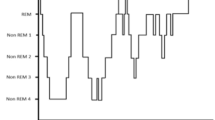Abstract
Polysomnograhy is the standard method for objectively measuring sleep, both in patient diagnostics in the sleep laboratory and in clinical research. However, the correspondence between this objective measurement and a person’s subjective assessment of the sleep quality is surprisingly small, if existent. Considering standard sleep characteristics based on the Rechtschaffen and Kales sleep models and the Self-rating Sleep and Awakening Quality scale (SSA), the observed correlations are at most 0.35. An alternative way of sleep modelling - the probabilistic sleep model (PSM) characterises sleep with probability values of standard sleep stages Wake, S1, S2, slow wave sleep (SWS) and REM operating on three second long time segments. We designed sleep features based on the PSM which correspond to the standard sleep characteristics or reflect the dynamical behaviour of probabilistic sleep curves. The main goal of this work is to show whether the continuous sleep representation includes more information about the subjectively experienced quality of sleep than the traditional hypnogram. Using a linear combination of sleep features an improvement in correlation with the subjective sleep quality scores was observed in comparison to the case when a single sleep feature was considered.
Access this chapter
Tax calculation will be finalised at checkout
Purchases are for personal use only
Similar content being viewed by others
Notes
- 1.
Nowadays, the American Academy of Sleep Medicine (AASM) sleep model is preferred in the clinical praxis, but we do not expect significant changes in results when using the AASM scores instead of the Rechtschaffen and Kales sleep model.
References
Buysse, D.J., et al.: Relationships between the Pittsburgh Sleep Quality Index (PSQI), Epworth Sleepiness Scale (ESS), and clinical/polysomnographic measures in a community sample. J. Clin. Sleep Med. 4(6), 563–571 (2008)
Edinger, J.D., et al.: Psychomotor performance deficits and their relation to prior nights’ sleep among individuals with primary insomnia. Sleep 31(5), 599–607 (2008)
Rosipal, R., Lewandowski, A., Dorffner, G.: In search of objective components for sleep quality indexing in normal sleep. Biol. Psychol. 94(1), 210–220 (2013)
Lewandowski, A., Rosipal, R., Dorffner, G.: Extracting more information from EEG recordings for a better description of sleep. Comput. Methods Programs Biomed. 108(3), 961–972 (2012)
Saletu, B., et al.: Short-term sleep laboratory studies with cinolazepam in situational Insomnia induced by traffic noise. Int. J. Clin. Pharmacol. Res. 7(5), 407–418 (1987)
Klosch, G., et al.: The SIESTA project polygraphic and clinical database. IEEE Eng. Med. Biol. Mag. 20(3), 51–57 (2001)
Jain, A., Zongker, D.: Feature selection: evaluation, application, and small sample performance. IEEE Trans. Pattern Anal. Mach. Intell. 19(2), 153–158 (1997)
James, G.M.: Curve alignment by moments. Ann. Appl. Stat. 1(2), 480–501 (2007)
Anderer, G., Gruber, S., Parapatics, M., Woertz, T., Miazhynskaia, G., Klösch, B., Saletu, J., Zeitlhofer, M., Barbanoj, H., Danker-Hopfe, S., Himanen, B., Kemp, T., Penzel, M., Grőzinger, D., Kunz, P., Rappelsberger, A., Schlögl, G., Dorffner, G.: An E-health solution for automatic sleep classification according to Rechtschaffen and Kales: validation study of the Somnolyzer 24 \(\times \) 7 utilizing the SIESTA database. Neurophysiology 51, 115–133 (2005)
MATLAB, version 8.3.0 (R2014a), The MathWorks Inc., Natick, Massachusetts (2014)
Acknowledgements
This research was supported by the Ernst Mach Stipendien der Aktion Österreich–Slowakei ICM-2016-03516, the Slovak Research and Development Agency (grant number APVV–0668–12), the Ministry of Health of the Slovak Republic (grant number MZ 2012/56–SAV–6) and by the VEGA 2/0011/16 grant. Dr. Aydemir’s contribution was supported by a scholarship from The Scientific and Technological Research Council of Turkey (TUBITAK).
Author information
Authors and Affiliations
Corresponding author
Editor information
Editors and Affiliations
Rights and permissions
Copyright information
© 2017 Springer International Publishing AG
About this paper
Cite this paper
Rošt’áková, Z., Dorffner, G., Aydemir, Ö., Rosipal, R. (2017). Estimation of Sleep Quality by Using Microstructure Profiles. In: ten Teije, A., Popow, C., Holmes, J., Sacchi, L. (eds) Artificial Intelligence in Medicine. AIME 2017. Lecture Notes in Computer Science(), vol 10259. Springer, Cham. https://doi.org/10.1007/978-3-319-59758-4_12
Download citation
DOI: https://doi.org/10.1007/978-3-319-59758-4_12
Published:
Publisher Name: Springer, Cham
Print ISBN: 978-3-319-59757-7
Online ISBN: 978-3-319-59758-4
eBook Packages: Computer ScienceComputer Science (R0)




